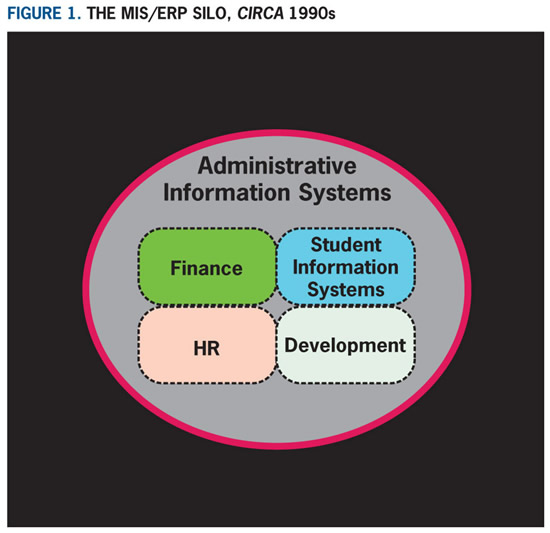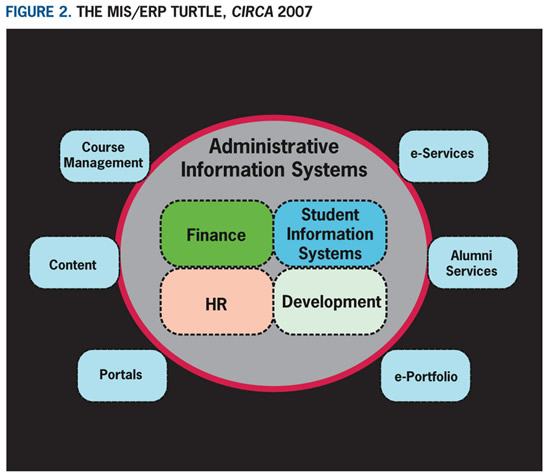
© 2007 Kenneth C. Green
EDUCAUSE Review, vol. 42, no. 6 (November/December 2007): 148–149
Prodding the ERP Turtle
When Susan Jones began her faculty career as a newly hired assistant professor of literature at "Acme University" in the fall of 1992, her institution, like many others, was about to embark on a major investment in a management information system (MIS). Advocates for the MIS—senior campus administrators as well as faculty from the information systems department in the business school—described the new system as one that would provide "more, better, and faster": more data, better information, and faster than ever before. Part of the public conversation about the need for the MIS focused on something called EDI (electronic data interchange), a new technology that would allow the individual components of the information system, primarily student records and campus finance, to exchange data—or, in "civilian terms," to talk with one another.
Recalling her experiences as a graduate student teaching assistant, and also her part-time job as an adjunct at a local college while completing her dissertation, Jones thought the investment in an MIS was really about institutional issues that would have little impact on her activities as a professor. Her primary interaction with the university's student information system involved official class lists, which often seemed incomplete and arrived late in the term. Still, she was intrigued by the oft-heard claim that this new MIS would offer some services that would benefit both individual faculty and academic departments. For a campus that had experienced major enrollment and financial upheavals in the 1980s and 1990s, Acme's investment in an MIS seemed like a reasonable, if expensive, investment. But as a recently hired assistant professor, Jones thought she had little experience or expertise to contribute to the campus conversation about the MIS.
That was then. Today Jones is a tenured professor and chair of the literature department at Acme. She has served on a number of key campus planning and policy committees. Her campus experience now includes two years as an assistant vice-provost for academic affairs, during which time she co-chaired the committee that prepared the university's recent self-study report for accreditation. Her academic and administrative experiences over the past fifteen years have given Jones a new appreciation for the role of campus information systems. Although not a "techie" by training or avocation, Jones, like many of her faculty colleagues across a range of disciplines, has learned a lot about IT planning, policy, and resources.
And today at Acme, the university is again in the midst of a major upgrade to its administrative information system, rechristened the ERP. This time, however, Jones is engaged in both the public discussions and the formal planning. Yet Jones, like many of her colleagues, remains a bit perplexed by what she sees as the semantic enhancement of the campus discussion about the university's administrative systems. What, she wonders, is the difference between an MIS and an ERP, between EDI and Web Services? The explanations offered at Wikipedia and by her more "techie" colleagues all sound very similar.
Admittedly, Susan Jones is not a real person, and Acme University is not a real institution. However, the narrative above fairly summarizes the real experiences of tens of thousands of faculty members over the past two decades. Often on the periphery of the campus discussions (debates?) about the information systems that help manage the academic enterprise, many faculty recall the often perplexing jargon as well as the promises—explicit, implied, and easily inferred—about how a new administrative system, initially an MIS and now an ERP, would advance and enhance campus management and services.
A large proportion of today's professorate "came of age" professionally in the 1980s and 1990s as institutions across the country began making strategic (and significant) investments in administrative information systems. During these years, the administrative information systems at colleges and universities were structured as a protected silo, intended to collect and protect key institutional data related to institutional finances, student records, human resources, and development initiatives (see Figure 1). Institutions typically established strict policies and procedures to "protect" the integrity of the data in these systems and also to keep outsiders—especially faculty—away from the individual student records and aggregated institutional data. Moreover, beginning in the late 1970s, the Family Educational Rights and Privacy Act (FERPA) provided campus officials with cover to restrict access to student records, even when the use of aggregated student data was legal and appropriate for key institutional research projects (e.g., retention and outcome studies).

Today the landscape of ERP and Web services looks very different. The past fifteen years have seen the emergence of a wide, rich, and mission-critical array of student and institutional services that are directly linked to core campus information services (or ERP functions). Yet these new functions and services—alumni services, course/learning management systems, digital content, e-portfolios, e-services (online registration, fee payment, etc.), and portals—are all firmly dependent not only on the Web but also on real-time interaction with the core elements of the "old" MIS, particularly student records and institutional finances. Moreover, unlike the "old" MIS, which was a protected silo inaccessible to both students and faculty, these new ERP resources and services are, by definition, open and interactive: students and faculty "touch" them daily.
Iconographically, these new functions reside on the periphery of the old MIS silo—on the outside of the boundaries that protected the core elements of campus information from "outsiders." Yet these new functions have become part of the de facto core of campus information resources and services. Allowing for some graphic license, the new map of the campus ERP looks a little like a turtle: outside of the hard "shell" protecting what were once the core elements of the administrative information system are the new Web-based functions, resources, and services that are (a) an essential set of campus resources and (b) dependent on data elements residing in the core (see Figure 2).

These new Web-based functions, resources, and services have been a catalyst for change in the core. For example, an effective course or learning management system (LMS) needs a direct link into the student information system (SIS). Why? Because key data about students who use the LMS reside in the SIS. Moreover, it is impossible to do an effective assessment of the impact of an LMS on student learning and outcomes without key data from the SIS.1 The same principle holds true for the campus portal, e-portfolio services, alumni services, digital content, and various e-services: key data elements from the core (particularly the SIS) are essential both for the functionality and for an assessment of these resources and services.
Unfortunately, the turtle is more than a graphic metaphor. On too many campuses, it is also an operational metaphor: core information systems remain in hard-shelled silos, "protected" by both old code and outdated policy. The elements that propel the new, integrated ERP reside outside of this hard shell. And movement (change) comes slowly, turtle-like. For example, it is only now, fully a decade after the emergence of the LMS and portals as key instructional and service resources, that institutions and the campus ERP providers have begun to link these functions to the traditional core campus information systems.
Of course some will argue that campuses must proceed slowly—cautiously—with major changes to the design and implementation of campus information systems: the systems are complex; integrating code and data from various providers is no small task and also involves significant expense; and the challenge includes both change management (involving people and campus processes) and technology.
These are all valid arguments, and yet, they are all increasingly irrelevant. Postsecondary institutions and their ERP providers must accelerate the integration of the elements of the ERP turtle—both the core information elements and the interactive Web-based functions, resources, and services. The "bring data" mandates emerging from the Spellings Commission,2 coupled with rising student and faculty expectations about online instructional resources and institutional services, leave campuses and their ERP providers with no option other than to prod the ERP turtle as part of a broader—and continuing—institutional effort to leverage, enhance, and integrate IT resources and services.
1. See, for example, John P. Campbell, Peter B. DuBlois, and Diana G. Oblinger, "Academic Analytics: A New Tool for a New Era," EDUCAUSE Review, vol. 42, no. 4 (July/August 2007): 40–57, http://www.educause.edu/er/erm07/erm0742.asp, and Libby V. Morris, Catherine Finnegan, and Sz-Shyan Wu, "Tracking Student Behavior, Persistence, and Achievement in Online Courses," The Internet and Higher Education, vol. 8, no. 3 (2005): 221–31.
2. Kenneth C. Green, "Bring Data: A New Role for Information Technology after the Spellings Commission," EDUCAUSE Review, vol. 41, no. 6 (November/December 2006): 30–47, http://www.educause.edu/er/erm06/erm0661.asp.
